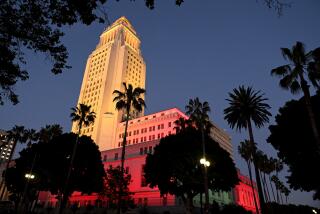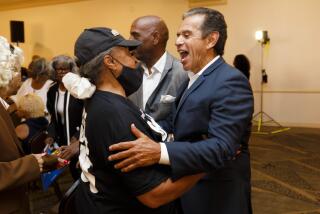One for you, one for Antonio
LAST MONDAY, Mayor Antonio Villaraigosa signed the second version of the Century Corridor hotel workers’ “living wage” bill into law. On the very same day, he created a new business post in his office and brought onboard a seasoned development expert. Maybe the timing was a coincidence.
It’s hard, though, not to see it as the latest example of how Villaraigosa is defining centrism in his own image. Think of it as “one for me, one for you” politics.
The business community hates the living-wage law. That government would decide how much to pay low-skilled workers is bad enough. That it would impose that decision on businesses with only a tangential link to city government is downright alarming.
No matter that Villaraigosa assures business that he won’t allow the living wage to be extended beyond the 13 hotels near the Los Angeles International Airport, or that the City Council, to alleviate business anxieties, has invented a convoluted procedure for deciding future living-wage extensions. Business leaders are convinced that the law is a foot in the door for a wider living-wage ordinance. That’s why the dispute is in court.
Villaraigosa backed the airport-hotel living wage from the start, not surprising for a guy who comes out of the labor movement and believes in economic “uplift” for the city’s low-wage workers. In signing both versions of the ordinance, he wanted to keep his labor allies happy, especially with some ticklish negotiations with city workers’ unions coming up this spring.
But when the business community and hotels threatened to call a referendum vote on the new law, which would have been expensive for the city, the City Council rescinded the ordinance. Villaraigosa could have let the council take the heat without losing any of his popular standing. Yet he jumped into negotiations to draft a new ordinance.
The mayor did his best to keep the business community at the table, and when its members walked away -- first the hotels, followed by representatives of the Chamber of Commerce -- he let them go without scolding them. Then, before signing the revised living-wage ordinance, he created the position of “deputy mayor for commercial and residential development” and tapped his veteran economic development aide, Bud Ovrom, for the job. He also brought in Helmi Hisserich, a longtime Hollywood development expert who worked for former Mayor Richard Riordan, to replace Ovrom. Ovrom will essentially be freed from a broad portfolio of responsibilities to become the city’s go-to guy for big development projects and to oversee efforts to streamline regulatory review of development proposals. Hisserich will focus on international trade, the port, workforce development and job creation. The message? Business may have taken a hit on the living wage, but Villaraigosa takes business development seriously enough to raise its profile in the mayor’s office. Or, to put it another way, one for me, one for you.
We’ve seen this approach before. Remember his veto of the council-approved $2.7-million settlement of firefighter Tennie Pierce’s racial-discrimination suit? It looked to be headed in a nasty direction within some African American circles -- the local chapter of the National Assn. for the Advancement of Colored People called the veto “an outrage” -- but Villaraigosa short-circuited the criticism by naming an African American as interim fire chief. He got to be tough on the budget and upright on firehouse culture -- and a black community uneasy with the city’s Latinization got a major city appointment. One for.... You get the idea.
Cynics might see all this as a variant of Clintonian triangulation, while Villaraigosa supporters would claim it’s evidence that the mayor takes his job of representing all Angelenos seriously. There’s a kernel of truth in each. More important, Villaraigosa’s “one for me, one for you” politics show that he has grasped a fundamental truth about governing a big U.S. city: He may be mayor, but to make his mark he has to depend on a lot of other people to drive the city forward. It’s not so much that he’s trying to be mayor for all of Los Angeles; it’s that he can’t be mayor without all of Los Angeles -- or at least a good cross section of it -- playing along.
Cities used to be a lot easier to govern. A wise observer of urban life in the South once said there was a time when, in any midsized Southern city, power generally rested with the newspaper publisher, a bank chairman, the utility president, a leading merchant, a Baptist minister and someone involved with the city’s dominant industry. These were the people a mayor or city manager sat down with to get things done. The observer could have been speaking -- with the possible exception of the minister -- about cities across the country. Certainly it’s a fair description (if you change some of the job titles and increase the number) of the Committee of 25, the businessmen who drove Los Angeles in the post-World War II years.
Making things happen in big cities today requires getting a virtual chessboard of players to go along: neighborhood groups, developers, corporate leaders, labor unions, religious leaders, pro-business groups, pro-working-poor groups and so on. In a city like Los Angeles, the list seems endless.
You want to green the port? You’ll need the longshore workers and the shipping companies. You want to plant a million trees in L.A.? You’ll need more than just the city workforce to put them in the ground. You want to revitalize downtown? You’ll need developers willing to spend billions, unions ready to make it happen, homeless advocates and the police able to work together with public and private social service agencies. If you fail to get all the competing groups on your side, lawsuits can slow you down for years. Look what’s happening to the mayor’s attempt to gain a greater say in the governance of L.A. Unified?
Small wonder that City Hall, like its counterparts across the country, is a crucible of moderation. It’s hard to govern from the extremes when you must talk to everyone. This is not to say that Villaraigosa, who came into office with a firm set of ideological beliefs, must abandon them to govern. Look at two of his “Sister Souljah” moments: his urging that students at last year’s big immigration rallies go back to school, and his veto of the Pierce settlement.
They indicated that the left didn’t own him -- but that didn’t mean that he was embracing the political center. Rather, the incidents, like his willingness to engage the city’s business leadership, signaled his drive to inhabit the city’s middle -- think of it as standing at the center of a circle, a point from which he can see and be accessible to everybody, regardless of ideology -- while pursuing his own agenda.
You might suppose that the need to negotiate with so many different people would be a drag on Villaraigosa’s power to accomplish what he wants. In truth, it lets him choose the right ally for the right moment, as when the mayor was able to enlist the longshore workers’ union to pressure shipping companies and other West Coast ports to reduce emissions from oceangoing vessels, or when the City Council essentially ran interference for him on the living-wage issue. To make this work, though, Villaraigosa has to keep all these interests at least content. So far, this balancing act has worked, though there will be times when it proves impossible. It’s when Villaraigosa decides that he’s powerful enough not to worry about the “one for you” part that L.A. is in trouble.
More to Read
Inside the business of entertainment
The Wide Shot brings you news, analysis and insights on everything from streaming wars to production — and what it all means for the future.
You may occasionally receive promotional content from the Los Angeles Times.










